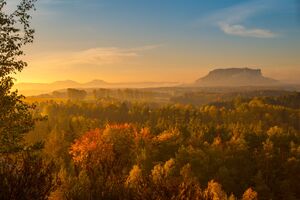National park
(Nature preserve, Black site) | |
|---|---|
 | |
| Their remote locations protected by special laws and forces make them ideal for covert activities. |
A national park is a natural park in use for conservation purposes, created and protected by national governments. Often it is a reserve of natural, semi-natural, or developed land that a sovereign state declares or owns. Although individual nations designate their own national parks differently, there is a common idea: the conservation of 'wild nature' for posterity and as a symbol of national pride.
Contents
Special areas
Often ruled by special laws and with their own forces to administer them and to keep people away, some parks have served as bases for covert activities. During the Cold War, national parks were ideal covers for stay-behind activities, from hiding weapons caches to rangers and foresters often being Gladio members[citation needed].
Many parks are in areas on the border between countries, making them suited for smuggling.
And billionaires take a keen interest in national parks, seeing them as their own playground.
Pakistan
In 1983, the WWF successfully persuaded the Pakistani government to create two national parks directly on the Afghan border in the northern region of Chitral. The remote region is not particularly renowned either for its abundance of animal life or the existence of endangered species, and presumably the flow of eco-turists into the region diminished during the Afghan War. Chitral is, however, renowned for the quality and abundance of its opium poppy, which was assiduously cultivated by the mujaheddin. It was also a primary staging area for smuggling arms into Afghanistan.[1]
South Africa
Apartheid South Africa hid covert activities such as parts of its chemical and biological program and mercenary bases inside national parks[citation needed].
Operation Lock
In 1987, the World Wildlife Fund for Nature under Prince Bernhard launched a project known as “Operation Lock,” ostensibly created to infiltrate and dismantle the African rhino horn and ivory trade. To execute the project, WWF hired KAS Enterprises, a private military firm that was also used to wage war on the enemies of apartheid South Africa trying to infiltrate the borders.[2]
Stephen Ellis, who broke a story on Operation Lock for the Independent in 1991, describes in his research how South African Military Intelligence exploited the trade of wildlife products throughout Africa for the larger effort of destabilizing the enemies of apartheid.[3]
“All of these trades tended to implicate senior government officials throughout [Africa], either because of their value, or their illegal or semi-legal nature required traders to buy political protection at a high level,” Ellis writes. “Hence, the infiltration of these networks by South African Military Intelligence was not only a means of making money but also a useful tool for South Africa’s secret servants to penetrate state machineries in pursuit of their strategy of destabilization.”[3]
Black market trade in wildlife products
Just like in the drug trade, which is run by deep state groups, projects such as Operation Lock might be a way to control the lucrative trade in wildlife products such as ivory and rhino horns, while eliminating the small time competition under guise of guarding the animals. The WWF is best-known for its efforts to conserve four animal species, all of which were in vastly better condition in 1961 than they are today. Two of these, the panda and the African black rhinoceros, are near extinction, and two others, the African elephant and the Indian tiger, are rapidly heading in that direction.[4]
Rewilding
While national parks are often seen as positive environmental service, they have a darker side. National parks were created by individuals who felt that pristine, natural sections of nature should be set aside and preserved from urban development.In many places, like the American West and India, the lands that havebeen set aside and protected were already being inhabited by native communities. So residents of these areas were removed and set aside to create "pristine" sites for public consumption.[5]
Billionaires such as Hansjörg Wyss are working to make at least 30% of the earth into wildlife reserves.
Green militarization
The South African government's National Integrated Strategy to Combat Wildlife Trafficking (NISCWT), established in 2017, focuses primarily on expanding policing to prevent wildlife trafficking. This approach deploys ‘green militarization,’ which involves war-based tactics involving people and military equipment to combat environmental emergencies and the threat of wildlife trafficking. In South Africa, park rangers are equipped with military gear and guns to protect the rhinos and deter poaching. The official procedure is to arrest poachers or potential poachers as illegal trespassers in national parks and reserves. However, many men who become poachers are killed, with the rest being imprisoned, thus creating anger and resistance to military-based conservation strategies from the affected rural communities.[6]
Operation CORDED
Operation CORDED is the codename given to the British Army’s involvement in the fight against poaching in the African country of Malawi and Zambia. The main task of Op CORDED is to train the rangers responsible for the day-to-day protection of the Park. As well as training the rangers in tracking, bushcraft and information analysis to improve the interception of poachers, the soldiers, designated as Counter-Poaching Operatives (CPOs), also taught infantry skills.[7][8]
An example
| Page name | Description |
|---|---|
| Presidio of San Francisco | Former military installation connected to serial killers and child abuse. |
References
- ↑ https://larouchepub.com/eiw/public/1995/eirv22n41-19951013/eirv22n41-19951013_025-sadruddin_aga_khan_mujahideen_co.pdf
- ↑ https://www.indybay.org/newsitems/2020/05/12/18832991.php
- ↑ a b https://www.scribd.com/doc/121327879/Kumleben-Commission-Report
- ↑ http://spikethenews.blogspot.com/2016/02/rhinos.html
- ↑ https://dx.doi.org/10.5749/j.ctv1bkc3t6
- ↑ https://www.mironline.ca/rhino-poaching-green-militarization-in-south-africa/
- ↑ http://www.warfare.today/2019/05/08/operation-corded-the-british-army-in-malawi/
- ↑ https://www.army.mod.uk/news-and-events/news/2021/06/illegal-poachers-tied-up-by-corded/